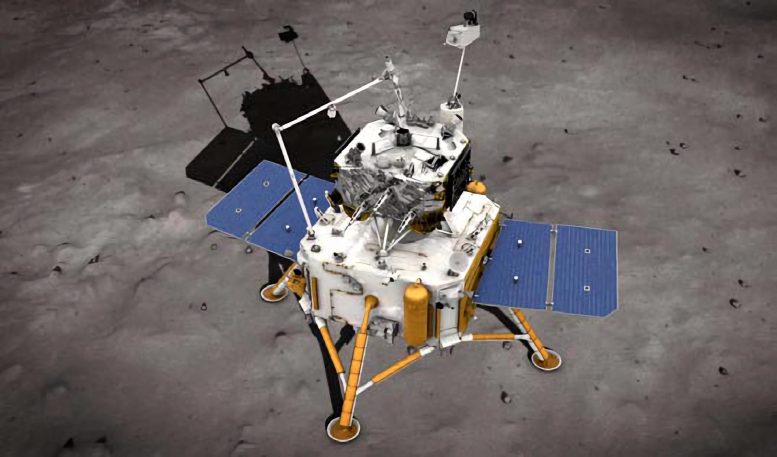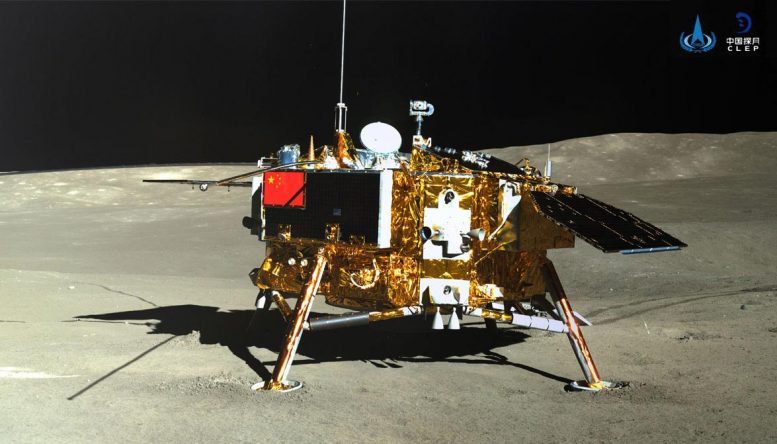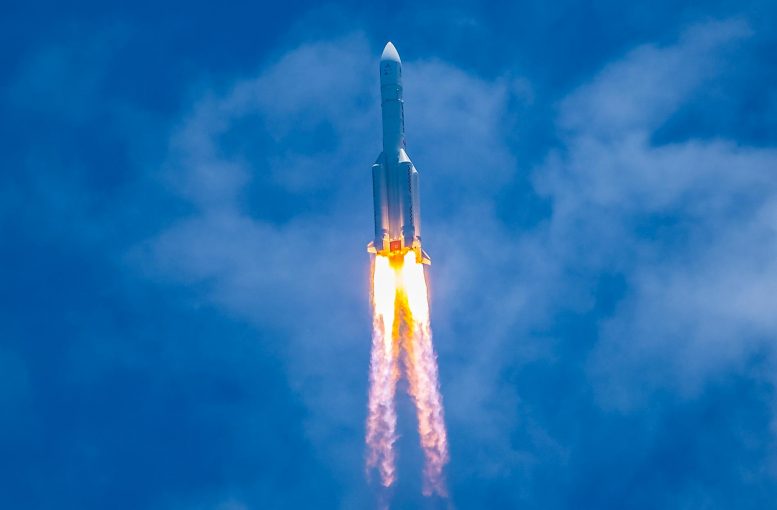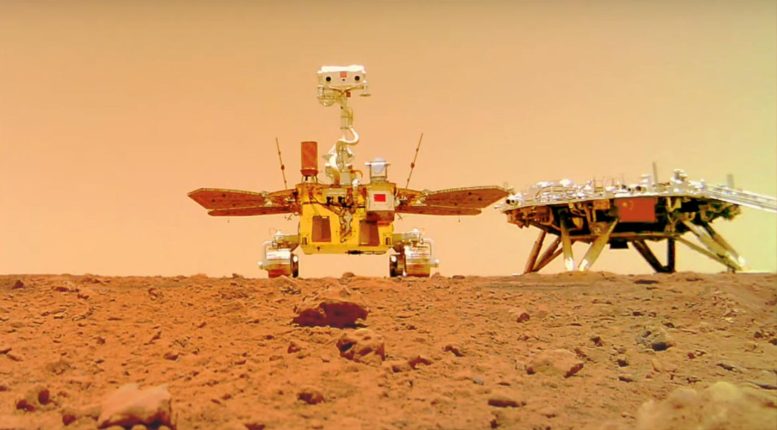
Chinese lunar and Martian missions unveiled far-side Moon secrets, Mars’ climate shifts, and unique lunar soil compositions, signaling groundbreaking insights for space exploration and planetary science.
The Chang’e-4 mission marked a pioneering lunar exploration by landing on the Moon’s far side, examining its unique soil and radiation environment, while Chang’e-5 revealed volcanic history and water preservation within lunar soil. Meanwhile, Tianwen-1’s Mars mission highlighted the planet’s climate evolution, aeolian landforms, and subsurface water evidence. Each mission contributes invaluable insights into planetary compositions, space weathering, and the history of our solar system’s bodies. These findings pave the way for future lunar and Martian exploration, enhancing our understanding of planetary processes and habitability.

CE-4 Mission
The Chang’e-4 mission made history as the first spacecraft to land on the Moon’s far side, specifically in the Von Kármán crater within the South Pole-Aitken Basin (45.457°S, 177.588°E), an area with an estimated geological age of 3.6 billion years.
At the landing site, scientists observed regolith with an average grain size of 15 µm, covered by layers of ejecta up to 70 meters thick. Spectral analysis revealed the presence of olivine and low-calcium pyroxene, indicating that this material likely originated from the Moon’s deep mantle. Thermal tests showed that the regolith has efficient heat-insulating properties, and radar imaging uncovered detailed subsurface structures. Additionally, the high levels of radiation detected, including Energetic Neutral Atom (ENA) flux from solar wind interactions, offered valuable insights into how the Moon’s surface interacts with solar wind.
ASAN and LND Instruments: Probing the Lunar Environment
The Chang’E-4 mission provides a unique opportunity to reveal the space environment on the lunar far side, with the Advanced Small Analyzer for Neutrals (ASAN) and Lunar Lander Neutron and Dosimetry (LND) instruments onboard the Yutu-2 rover. The ASAN instrument is designed to measure the low-energy particles from the solar wind-surface interaction.
A partially-formed lunar mini-magnetosphere has been observed by ASAN, where no shock but just a boundary layer can be found near the magnetic anomalies. In addition, the energy spectra of energetic neutral atoms scattered from the lunar surface, as well as their dependences on the solar wind, have been detected by ASAN. The LND instrument has performed the first active dosimetric measurements on the lunar surface. It is found that the interaction of GCRs with the lunar regolith can result in upward-directed albedo protons, and the ratio of albedo protons to primary protons in the energy range of 64.7-76.7 MeV has been obtained with the LND measurements.
Additionally, the spectra of cosmic rays in the energy range of 10 to 100 MeV/nuc have been measured by LND, which is a little bit different from those measured by the near-earth spacecraft, and suggests a non-negligible contribution of secondary particles to the surface radiation environment. These results have done much to improve our understanding of the lunar space environment and are very helpful for future lunar explorations.

CE-5 Mission
Compositional analyses of the lunar soil have revealed higher concentrations of FeO, along with moderate levels of TiO2 and Al2O3. Analyses have shown that much of the lunar soil from the Chang’E-5 mission likely originated from the Xu Guangqi crater, northwest of the landing site, and is characterized by a high degree of maturity, a condition largely attributed to the extensive micrometeoroid impacts in the region. Micrometeoroid impacts have led to the predominance of spallation processes in the formation of the soil.
The average particle size of the Chang’E-5 soils is around 50 μm, with a relatively low glass content. Basaltic fragments are composed of clinopyroxene, plagioclase, olivine, and ilmenite, with textures varying from porphyritic to ophitic and poikilitic. While previous analyses suggested abundant olivine, laboratory studies revealed the presence of iron-rich high-Ca pyroxene, challenging prior assumptions about the mineral composition of this lunar region.
Impact Glasses and Space Weathering
Impact glasses found in the Chang’E-5 samples display diverse forms, including ultra-elongated fibers and amorphous layers without np-Fe0, indicative of a moderate impact environment. The composition points to a primarily local origin, with transport distances limited to 150 km or less. U-Pb isotopic dating suggests these glasses formed between a few million and two billion years ago, younger than the basalts. Additionally, KREEP-rich impact glass has been discovered, possibly originating from the boundary between the P58/Em4 mare unit and adjacent highlands.
Space weathering studies on Chang’E-5 samples show that iron-rich basalts experience rapid formation of np-Fe0, which aggregates into larger particles. The discovery of np-Fe0 in amorphous layers on fayalitic olivine surfaces provides new insights into space weathering mechanisms. This phenomenon is primarily driven by micrometeoroid impacts, with only minimal contribution from solar wind injection. Furthermore, lunar agglutinate glasses contain np-Fe0 and Fe3+, which increase with ongoing micrometeoroid impacts.
New Mineral Discoveries: Trigonal and Triclinic TiO
A notable discovery in the Chang’E-5 samples is the presence of iron meteorite fragments, classified as part of the IID group based on their Ni- and P-rich, S-poor composition. These fragments formed through low-velocity impacts and provide valuable information on lunar impact processes. Additionally, newly discovered minerals, such as trigonal Ti2O and triclinic Ti2O, were found in micrometeorite impact craters on glass beads, enhancing our understanding of space weathering effects.
Sulfides in the Chang’E-5 samples, though constituting less than 1%, also reveal impact-induced weathering. Magnetite and np-Fe0 particles were observed in iron-sulfide particles, formed by eutectoid reactions, providing evidence of significant impact events on the lunar surface.
Solar Wind-Derived Water
Solar wind-derived water is another critical finding, with more than 170 ppm of water detected in the Chang’E-5 samples, consistent with lunar surface spectral measurements. Impact glasses in the lunar soil contain 15 to 25 ppm of molecular water, primarily solar wind-derived. These glasses are essential for preserving water and help sustain the lunar surface water cycle. The concentration of solar wind-derived water in glass beads can reach up to 2000 ppm, with an average of about 500 ppm.
Basalts and Lunar Magmatic Activity
The petrogenesis of the Chang’E-5 basalts suggests they originated from an olivine-bearing pyroxenite mantle source at pressures of (1.0–1.3)×103 MPa and temperatures around 1350 ± 50 °C. These basalts indicate that lunar magmatic activity persisted until at least 2 billion years ago, suggesting the Moon experienced large-scale volcanic eruptions later than previously thought. The Chang’E-5 basalts exhibit rapid cooling with shorter degassing periods compared to Apollo samples, and the latest findings suggest evidence of volcanic activity on the Moon as recently as 120 million years ago.

Tianwen-1 Mission
China’s Tianwen-1 mission, featuring the Zhurong rover, has made remarkable progress in uncovering the geological and environmental history of Mars, particularly in the southern Utopia Planitia region. Combining advanced instruments such as low-frequency radar, multispectral imaging, and environmental sensors, the mission has provided a comprehensive understanding of both the surface and subsurface structures of Mars. These discoveries are shedding new light on the planet’s dynamic past, offering clues about water-related processes and climate shifts.
Mars’ Aeolian Landforms and Climate Shifts
One of the key findings involves the dynamic changes in Martian Aeolian landforms, particularly Transverse Aeolian Ridges (TARs) and dunes. These structures, initially shaped by northern winds and later reworked by northeastern winds, reflect the planet’s complex climatic history. The observed changes in dune morphology align with the end of Mars’ most recent ice age, suggesting a major transition from glacial to interglacial periods. This transition was marked by significant wind regime shifts, which reshaped the Martian landscape, providing critical evidence of the evolving Martian climate.

Subsurface Stratigraphy and Martian Water History
The radar data collected by the Zhurong rover has revealed detailed subsurface stratigraphy, exposing sedimentary sequences at depths of 10 to 80 meters. These sequences indicate multiple resurfacing events that likely occurred during the late Hesperian period (approximately 3.5 to 3.2 billion years ago) and possibly extended into the Amazonian period. This points to the possibility of water-related geological processes continuing far longer than previously believed. Furthermore, spectroscopic studies have detected the presence of water-bearing minerals, such as polyhydric sulfates and gypsum, which support theories of a once wetter Mars, potentially with subsurface glaciers or permafrost.
Martian Dust and Temperature Regulation
Environmental sensors on the Zhurong rover have provided vital data on Martian dust deposition, wind dynamics, and surface temperatures. During the Martian spring and summer, strong winds were found to significantly influence dust deposition rates, a critical factor in understanding Martian current surface conditions. Thermal inertia and dust have been identified as key contributors to the regulation of surface temperatures, especially during periods of increased dust storm activity.
Water-related processes have also been a key focus of the mission. While liquid water is unlikely to be stable at shallow depths, there is evidence of brine ice deposits near the surface. The Mars Climate Station (MCS) aboard Zhurong rover has regularly recorded frost formation, which sublimates after sunrise, suggesting active water vapor cycles. This observation provides crucial insight into the interactions between the Martian atmosphere and surface.
In conclusion, the Tianwen-1 mission has delivered significant insights into Martian geological and environmental conditions, particularly its water history and climatic evolution. These discoveries have important implications for whether there was potential life on ancient Mars and provide a foundation for future missions aimed at exploring Martian habitability.
Interplanetary Observations and Solar Wind Dynamics
The Martian space environment investigation is carried out mainly based on insitu observations on board Tianwen-1 orbiter. Comparisons between Tianwen-1 and other Earth & Mars based observations confirmed a general consistency among missions. Data correction and retrieval algorithms have been developed to improve data quality or provide supporting data. Remote sensing of the interplanetary media, radio occultation of the ionosphere and atmosphere were also explored using the VLBI data.
Observations reveal that up to Mars, the background solar wind is important in determining the interplanetary evolution and global morphology of ICMEs; A small but finite cross-field diffusion is crucial to understanding the formation of the SEP reservoir phenomenon. The foreshock waves are highly distorted. The Martian bow shock is rapidly compressed and then expanded in response to the dynamic pressure pulse in the solar wind, and also oscillates during the IMF rotation.
The altitude of the Martian ionopause location was lowered during the ICME. The depletion of the plasma density in the topside Martian ionosphere on the nightside reveals the presence of substantial ion and electron escape. The planetary heavy ions picked up by the solar wind mostly originate from middle and low MSE (Mars Solar Electric) latitude of the northern dayside Martian ionosphere. Enhanced acceleration of pickup ions inside the magnetosheath by the motional electric field located at the upper edge or within the Magnetic Pileup Boundary. The observations were also used to evaluate the performance of an operational solar wind prediction system, to predict the arrival time and in-situ parameters of corotating interaction regions (CIRs).
Reference: “Latest Scientific Results of China’s Lunar and Deep Space Exploration (2022–2024)” by Lin Xu, Lei Li, Jianzhong Liu, Honglei Lin, Yang Li, Yang Liu, Lianghai Xie, Jinhai Zhang, Fuhao Qiao, Juanjuan Han and Yongliao Zou, 4 September 2024, Chinese Journal of Space Science.
DOI: 10.11728/cjss2024.04.2024-yg10




